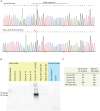Endothelial TRPV4-Cx43 signalling complex regulates vasomotor tone in resistance arteries
- PMID: 39982706
- PMCID: PMC12333910
- DOI: 10.1113/JP285194
Endothelial TRPV4-Cx43 signalling complex regulates vasomotor tone in resistance arteries
Abstract
S-nitrosylation of Cx43 gap junction channels critically regulates communication between smooth muscle cells and endothelial cells. This post-translational modification also induces the opening of undocked Cx43 hemichannels. However, its specific impact on vasomotor regulation remains unclear. Considering the role of endothelial TRPV4 channel activation in promoting vasodilatation through nitric oxide (NO) production, we investigated the direct modulation of endothelial Cx43 hemichannels by TRPV4 channel activation. Using the proximity ligation assay, we identified that Cx43 and TRPV4 are found in close proximity in the endothelium of resistance arteries. In primary endothelial cell (EC) cultures from resistance arteries, GSK 1016790A-induced TRPV4 activation enhances eNOS activity, increases NO production, and opens Cx43 hemichannels via direct S-nitrosylation. Notably, the elevated intracellular Ca2+ levels caused by TRPV4 activation were reduced by blocking Cx43 hemichannels. In ex vivo mesenteric arteries, inhibiting Cx43 hemichannels reduced endothelial hyperpolarization without affecting NO production in ECs, underscoring a critical role of TRPV4-Cx43 signalling in endothelial electrical behaviour. We perturbed the proximity of Cx43/TRPV4 by disrupting lipid rafts in ECs using β-cyclodextrin. Under these conditions, hemichannel activity, Ca2+ influx and endothelial hyperpolarization were blunted upon GSK stimulation. Intravital microscopy of mesenteric arterioles in vivo further demonstrated that inhibiting Cx43 hemichannel activity, NO production and disrupting endothelial integrity reduce TRPV4-induced relaxation. These findings underscore a new pivotal role of the Cx43 hemichannel associated with the TRPV4 signalling pathway in modulating endothelial electrical behaviour and vasomotor tone regulation. KEY POINTS: TRPV4-Cx43 interaction in endothelial cells: the study reveals a close proximity between Cx43 proteins and TRPV4 channels in endothelial cells of resistance arteries, establishing a functional interaction that is critical for vascular regulation. S-nitrosylation of Cx43 hemichannels: TRPV4 activation via GSK treatment induces S-nitrosylation of Cx43, facilitating the opening of Cx43 hemichannels. TRPV4-mediated calcium signalling: activation of TRPV4 leads to increased intracellular Ca2+ levels in endothelial cells, an effect that is mitigated by the inhibition of Cx43 hemichannels, indicating a regulatory feedback mechanism between these two channels. Endothelial hyperpolarization and vasomotor regulation: Blocking Cx43 hemichannels impairs endothelial hyperpolarization in mesenteric arteries, without affecting NO production, suggesting a role for Cx43 in modulating endothelial electrical behaviour and contributing to vasodilatation. In vivo role of Cx43 hemichannels in vasodilatation: intravital microscopy of mouse mesenteric arterioles demonstrated that inhibiting Cx43 hemichannel activity and disrupting endothelial integrity significantly impair TRPV4-induced vasodilatation, highlighting the crucial role of Cx43 in regulating endothelial function and vascular relaxation.
Keywords: ECs; caveolae; hyperpolarization; resting membrane potential.
© 2025 The Author(s). The Journal of Physiology published by John Wiley & Sons Ltd on behalf of The Physiological Society.
Conflict of interest statement
No competing interests declared.
Figures











Update of
-
Endothelial TRPV4/Cx43 Signaling Complex Regulates Vasomotor Tone in Resistance Arteries.bioRxiv [Preprint]. 2024 Jul 25:2024.07.25.604930. doi: 10.1101/2024.07.25.604930. bioRxiv. 2024. Update in: J Physiol. 2025 Aug;603(15):4345-4366. doi: 10.1113/JP285194. PMID: 39091840 Free PMC article. Updated. Preprint.
References
-
- Adapala, R. K. , Talasila, P. K. , Bratz, I. N. , Zhang, D. X. , Suzuki, M. , Meszaros, J. G. , & Thodeti, C. K. (2011). PKCalpha mediates acetylcholine‐induced activation of TRPV4‐dependent calcium influx in endothelial cells. American Journal of Physiology‐Heart and Circulatory Physiology, 301(3), H757–H765. - PMC - PubMed
-
- Archer, S. L. , Gragasin, F. S. , Wu, X. , Wang, S. , McMurtry, S. , Kim, D. H. , Platonov, M. , Koshal, A. , Hashimoto, K. , Campbell, W. B. , Falck, J. R. , & Michelakis, E. D. (2003). Endothelium‐derived hyperpolarizing factor in human internal mammary artery is 11,12‐epoxyeicosatrienoic acid and causes relaxation by activating smooth muscle BK(Ca) channels. Circulation, 107(5), 769–776. - PubMed
-
- Berridge, M. J. (2009). Inositol trisphosphate and calcium signalling mechanisms. Biochimica et Biophysica Acta, 1793(6), 933–940. - PubMed
-
- Billaud, M. , Lohman, A. W. , Straub, A. C. , Looft‐Wilson, R. , Johnstone, S. R. , Araj, C. A. , Best, A. K. , Chekeni, F. B. , Ravichandran, K. S. , Penuela, S. , Laird, D. W. , & Isakson, B. E. (2011). Pannexin1 regulates alpha1‐adrenergic receptor‐ mediated vasoconstriction. Circulation Research, 109(1), 80–85. - PMC - PubMed
MeSH terms
Substances
Grants and funding
LinkOut - more resources
Full Text Sources
Miscellaneous
